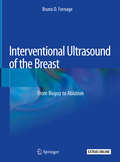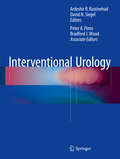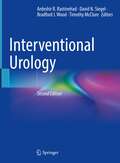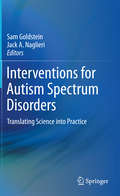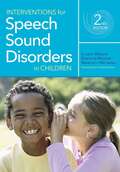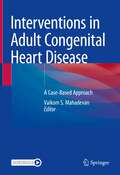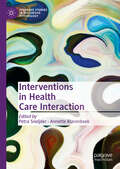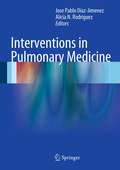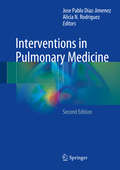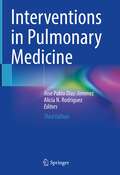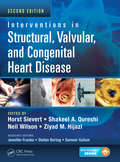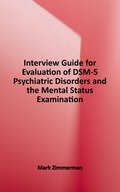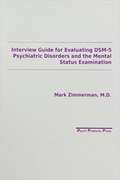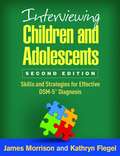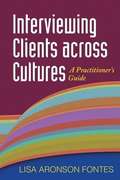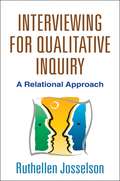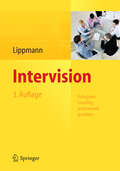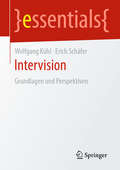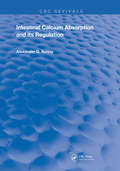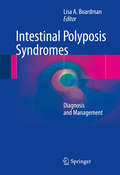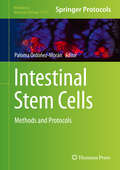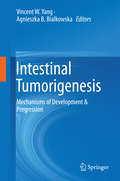- Table View
- List View
Interventional Ultrasound of the Breast: From Biopsy to Ablation
by Bruno D. FornageThis book is the premier guide to ultrasound-guided interventions of the breast. Written by Bruno D Fornage, a world-renowned leader in the fields of breast ultrasound and ultrasound-guided interventions, it covers in detail techniques of freehand ultrasound-guided breast biopsy, placement of post-biopsy markers, localization of nonpalpable lesions, and percutaneous ablation of breast masses. A large part of the book describes the highly effective combined use of fine-needle aspiration and core-needle biopsy during the staging of breast cancer; this combination has been used successfully by the author at MD Anderson Cancer Center for 3 decades. Throughout the book, the author shares numerous tips and tricks, many of which have not been published before. With over 1300 figures and and 200 videoclips depicting ultrasound-guided procedures, Interventional Ultrasound of the Breast is the authoritative resource for breast imagers, interventional radiologists, surgical breast oncologists, pathologists, and anyone who embarks on ultrasound-guided breast biopsies and other breast procedures. In addition, the techniques described in this book are applicable to many other areas of the body, including the thyroid and soft tissues.
Interventional Urology
by Ardeshir R. Rastinehad David N. Siegel Peter A. Pinto Bradford J. WoodThis book provides a concise yet comprehensive summary of the evolving techniques and current status of interventional urology. The book is organized by organ system with subtopics covering imaging technologies, interventional techniques, and clinical outcomes for the vast variety of interventional urologic procedures. It represents the first single text covering these topics and will help guide patient management and stimulate investigative efforts. Written by experts in the field, Interventional Urology provides a richly illustrated, image-guided, state-of-the art review of this new field, that will serve as a valuable resource for clinicians, interventional urologists, interventional radiologists, researchers, and residents with an interest in interventional urology.
Interventional Urology
by Ardeshir R. Rastinehad David N. Siegel Bradford J. Wood Timothy McClureThis updated text provides a concise yet comprehensive and state-of-the-art review of evolving techniques in the new and exciting subspecialty of interventional urology. Significant advances in imaging technologies, diagnostic tools, fusion navigation, and minimally invasive image-guided therapies such as focal ablative therapies have expanded the interventional urologists’ clinical toolkit over the past decade. Organized by organ system with subtopics covering imaging technologies, interventional techniques, recipes for successful practice, pitfalls to shorten the learning curves for new technologies, and clinical outcomes for the vast variety of interventional urologic procedures, this second edition includes many more medical images as well as helpful graphics and reference illustrations. The second edition of Interventional Urology serves as a valuable resource for clinicians, interventional urologists, interventional radiologists, interventional oncologists, urologic oncologists, as well as scientists, researchers, students, and residents with an interest in interventional urology.
Interventions for Autism Spectrum Disorders
by Sam Goldstein Jack A. NaglieriChildren are being diagnosed with autism spectrum disorders at a staggering rate--as many as one in 110, according to some studies. To this sobering statistic add the familiar figures of the toddler disengaged from his peers, the middle schooler shunned in the lunchroom, and the adult struggling with social cues on the job, and professionals are faced with a mounting challenge: to assist and support young people with these disorders to ensure their successful transition to adolescence and adulthood. The first volume dedicated solely to its topic, Interventions for Autism Spectrum Disorders provides a comprehensive overview of programs currently in use. Contributors explore programs focusing on long-term outcomes, home- and classroom-based strategies, resilience training for parents, and pharmacological management of symptoms. Background chapters review issues in reliability and validity of interventions and evaluating treatment effectiveness. And an especially cogent chapter discusses the centrality of treatment integrity to best practice. Comprehensive programs and targeted interventions covered include: The Early Start Denver Model for young children.The TEACCH program for children, adults, and families.The Center for Autism and Related Disorders (CARD) and CARD eLearning.PROGress: a program for remediating and expanding social skills.Evidence-based strategies for repetitive behaviors and sensory issues.Self-regulation strategies for students with autism spectrum disorders.Interventions for Autism Spectrum Disorders is an essential resource for researchers, professionals/practitioners, and clinicians in a wide array of fields, including clinical child, school, and developmental psychology; child and adolescent psychiatry; education; rehabilitation medicine/therapy; social work; and pediatrics.
Interventions for Speech Sound Disorders in Children
by Gail T. Gillon Joy Stackhouse Barbara Dodd Caroline Bowen Stephen Camarata Amy Clark Michelle Pascoe Rebecca J. McCauley Sharynne McLeod Alan Kamhi Kirrie J. Ballard Barbara May Bernhardt Francoise Brosseau-Lapre Joanne Cleland Sharon Crosbie Jennifer Eigen Jennifer R. Frey Allison M. Haskill Deborah A. Hayden Megan M. Hodge Barbara Hodson Alison Holm Ann P. Kaiser Megan C. Leece Jennifer Thompson Mackovjak Lesley C. Magnus Sarah Masso Brigid C. McNeill Adele W. Miccio Michele Morrisette Aravind K. Namasivayam Lindsay Pennington Jonathan L. Preston Raul Francisco Prezas Donald A. Robin A. Lynn Williams Susan Rvachew Nancy J. Scherer Edythe A. Strand Eleanor Sugden Ann A. Tyler Roslyn Ward Pam Williams Yvonne Wren Elise BakerAn essential building block of every speech-language pathologist’s professional preparation, the second edition of this bestselling textbook is a comprehensive critical analysis of 21 interventions for highly prevalent speech sound disorders (SSD) in children. Bringing together a powerhouse team of international experts, this new edition has been revised and enhanced with current research, new interventions, more guidance on selecting interventions, and updated video clips that show the approaches in action. For each intervention, readers will get a clear explanation of its robust evidence base, plus thorough guidance on implementing the approach, monitoring progress, and using the intervention with children from culturally and linguistically diverse backgrounds. <p><p>A key graduate-level text and an important professional resource for practicing SLPs, early interventionists, and special educators, this book will help readers choose and use the best interventions for children with phonological or motor-based speech disorders.
Interventions in Adult Congenital Heart Disease: A Case-Based Approach
by Vaikom S. MahadevanThis book presents a series of illustrative cases to highlight the decision-making process in pursuing an interventional management strategy and the procedural details of performing catheter-based interventions in patients with adult congenital heart disease (ACHD). Each case provides a brief prior history of the patient, summary of current symptoms, pertinent physical examination findings, key imaging findings used to determine the indication for intervention as well as the technical feasibility of a transcatheter intervention. Potential management options and the rationale for why a transcatheter intervention was the optimal management strategy, and post-procedure management strategies are also discussed. Interventions in Adult Congenital Heart Disease: A Case-Based Approach provides a practical guide to successfully implementing a range of cardiac intervention management strategies, and is valuable resource for all cardiology practitioners and trainees seeking an up-to-date resource on the topic.
Interventions in Health Care Interaction (Palgrave Studies in Discursive Psychology)
by Petra Sneijder Annette KlarenbeekThis edited collection presents the latest work on the application of discursive psychology and conversation analysis to sensitive interactions and interventions in healthcare. While all interactions in healthcare settings can be challenging for both patients and practitioners, this book pays particular attention to topics that are likely to be especially sensitive, such as communication around sexual health, palliative care, suicide prevention, medically unexplained symptoms, or chronic pain. Across nine chapters authors discuss how discursive psychology and conversation analysis can help us understand what people actually do in conversations, hence providing a strong basis for developing and testing training methods that support health professionals to reflect on their interactions with patients. Addressing both practical and theoretical challenges in the development and implementation of such training sessions, this volume establishes the state-of-the-art in this area and offers a valuable tool for academics and researchers in discourse analytical fields, practitioners working to improve communication in health, as well as meeting facilitators in education or work settings related to healthcare.
Interventions in Pulmonary Medicine
by Alicia N. Rodriguez Jose Pablo Díaz-JimenezInterventions in Pulmonary Medicine is an important new volume that addresses all areas of interventional pulmonology, a minimally invasive endoscopic way to diagnose and treat lung disorders. This volume contains dedicated chapters that outline the many issues related to lung cancer, both in early and advanced stages, from diagnosis to personalized treatment. It also covers bronchoscopic therapeutic options to benign conditions that are highly prevalent, such as COPD and asthma. Techniques described in this volume are: laser therapy, argon plasma coagulation therapy, cryotherapy, brachytherapy, placement of intrapleural drainage systems, endoscopic treatment of emphysema, stents in the airway, and thermoplasty for bronchial asthma. Diagnostic procedures that are covered are: medical thoracoscopy, flexible and rigid bronchoscopy, endobronchial ultrasound, electromagnetical navigation, and trends in personalized treatment for lung cancer and other benign lung conditions. Chapters are written by experts and the developers of the techniques that are currently considered gold standard. Evidence-based reviews are presented for all topics and indications, and contraindications are discussed. Interventions in Pulmonary Medicine is a must have for pulmonologists, endoscopists, pulmonary oncologists, ENT physicians, thoracic surgeons, anesthesiologists, and intensive care specialists and their teams.
Interventions in Pulmonary Medicine
by Alicia N. Rodriguez Jose Pablo Díaz-JimenezInterventions in Pulmonary Medicine is an important new volume that addresses all areas of interventional pulmonology, a minimally invasive endoscopic way to diagnose and treat lung disorders. This volume contains dedicated chapters that outline the many issues related to lung cancer, both in early and advanced stages, from diagnosis to personalized treatment. It also covers bronchoscopic therapeutic options to benign conditions that are highly prevalent, such as COPD and asthma. Techniques described in this volume are: laser therapy, argon plasma coagulation therapy, cryotherapy, brachytherapy, placement of intrapleural drainage systems, endoscopic treatment of emphysema, stents in the airway, and thermoplasty for bronchial asthma. Diagnostic procedures that are covered are: medical thoracoscopy, flexible and rigid bronchoscopy, endobronchial ultrasound, electromagnetical navigation, and trends in personalized treatment for lung cancer and other benign lung conditions. Chapters are written by experts and the developers of the techniques that are currently considered gold standard. Evidence-based reviews are presented for all topics and indications, and contraindications are discussed. Interventions in Pulmonary Medicine is a must have for pulmonologists, endoscopists, pulmonary oncologists, ENT physicians, thoracic surgeons, anesthesiologists, and intensive care specialists and their teams.
Interventions in Pulmonary Medicine
by José Pablo Díaz-Jiménez Alicia N. RodríguezThis third edition offers comprehensive, up-to-date coverage of all areas of interventional pulmonology, a minimally invasive endoscopic method for diagnosing and treating lung disorders. The text is divided into nine sections on the major areas of interventional pulmonology, including basic bronchoscopy, lung cancer staging, tracheobronchial obstructions, endobronchial treatments for asthma and emphysema, as well as a new section on interventional procedures during the COVID-19 pandemic. Chapters explore specific procedures and techniques, including medical thoracoscopy, flexible and rigid bronchoscopy, endobronchial ultrasound, and electromagnetical navigation with coverage of history, indications and contraindications, up-to-date, evidence-based reviews, and recommendations. The COVID-19 pandemic has also changed medicine in many permanent ways, and that will be considered closely for every intervention. Additionally, there are new chapters on interventions in pediatric patients and artificial intelligence bronchoscopy, two topics that are not frequently covered. This inclusive volume concludes with a look towards both the past and future of interventional pulmonology with experimental techniques currently being tested. This volume is a must have for pulmonologists, interventional radiologists, thoracic surgeons, pulmonary oncologists, ENT physicians, anesthesiologists, intensive care specialists, and their teams.
Interventions in Structural, Valvular and Congenital Heart Disease
by Neil Wilson Horst Sievert Ziyad M. Hijazi Shakeel A. Qureshi Jennifer Franke Stefan Bertog Sameer GafoorAt one time, many children born with congenital heart disease (CHD) suffered from issues that carried fatal prognoses. But that's changing, thanks to technological advances. Interventions in Structural, Valvular, and Congenital Heart Disease, Second Edition guides you throught the interventional treatment of congenital, valvular, and stru
Interview Guide For Evaluating DSM-5-TR Psychiatric Disorders and the Mental Status Examination
by Mark ZimmermanThis book provides questions for evaluating psychiatric disorders. DSM-5-TR lists the disorders and their criteria, but it does not guide the beginner in inquiry for them. Students and clinicians in training are relatively unfamiliar with psychiatric diagnoses, and they cannot possibly remember all of the disorders and their corresponding diagnostic criteria within a short period of study. Moreover, it is often not obvious what questions to ask to determine the symptom's presence. How do you inquire for thought withdrawal, delusions of reference, panic attacks, obsessions, identity disturbance, mood instability, etc., Even more basic, how do you begin the interview? The Interview Guide consists of questions for the most common DSM-5 diagnoses including personality disorders. This book is not a standardized interview, to be started on page x and followed until page xx. Rather it is a quick reference to be used in the context of a clinical interview. If a patient complains of depression, the interviewer can turn to the section on major depression and assess the relevant symptoms. The book is organized by diagnosis and contains 9 sections.
Interview Guide for Evaluating DSM-5 Psychiatric Disorders and the Mental Status Examination
by Mark Zimmerman<p>This book provides questions for evaluating psychiatric disorders. DSM-5 lists the disorders and their criteria, but it does not guide the beginner in inquiry for them. Students and clinicians in training are relatively unfamiliar with psychiatric diagnoses, and they cannot possibly remember all of the disorders and their corresponding diagnostic criteria within a short period of study. Moreover, it is often not obvious what questions to ask to determine the symptom's presence. How do you inquire for thought withdrawal, delusions of reference, panic attacks, obsessions, identity disturbance, mood instability, etc? Even more basic, how do you begin the interview? <p>The Interview Guide consists of questions for the most common DSM-5 diagnoses including the personality disorders. This book is not a standardized interview, to be started on page x and followed until page xx. Rather it is a quick reference to be used in the context of a clinical interview. If a patient complains of depression, the interviewer can turn to the section on major depression and assess the relevant symptoms. If there is a suggestion of excessive drug or alcohol use, the interviewer can refer to the long list of questions for diagnosing a drug or alcohol use disorder.</p>
Interviewing Children and Adolescents: Skills and Strategies for Effective DSM-5 Diagnosis (Second Edition)
by James Morrison Kathryn FlegelThis instructive clinical resource has given thousands of clinicians and students essential skills for evaluating infants through adolescents with any type of mental health issue. Principles for conducting age-appropriate clinical interviews with children of varying ages and their parents--including the use of toys, drawing, dolls, and other forms of play--are illustrated with annotated sample transcripts. The book provides crucial information for accurately diagnosing a wide range of mental and behavioral disorders. User-friendly features include concise explanations of diagnostic criteria, coding notes, interview pointers for specific disorders, vivid vignettes, and a sample written report.
Interviewing Clients across Cultures
by Lisa Fontes Sandra Graham-BermannPacked with practical pointers and examples, this indispensable, straight-talking guide helps professionals conduct productive interviews while building strong working relationships with culturally and linguistically diverse clients. Chapters cover verbal and nonverbal ways to build rapport and convey respect; how to overcome language barriers, including effective use of interpreters; culturally competent interviews with children and adolescents; and key issues in working with immigrants and refugees. Strategies for avoiding common cross-cultural misunderstandings and producing fair, accurate reports are presented. Every chapter concludes with thought-provoking discussion questions and resources for further reading.
Interviewing for Qualitative Inquiry: A Relational Approach
by Ruthellen JosselsonEngagingly written, this book builds the reader's skills for conducting in-depth interviews designed to address a particular research question. With an emphasis on the dynamics of the research relationship, Ruthellen Josselson artfully demonstrates the steps of a successful interview. Each step is illustrated with excerpts from interviews on diverse topics. The book describes how to structure interviews effectively, develop questions that elicit meaningful narratives, cultivate skills for empathic listening and responding, avoid common pitfalls, and deal with problems that develop in an interview.Pedagogical features include:*Practice exercises adapted from Josselson's popular workshops.*Annotated examples of "good" and "bad" interviews.*A chapter on interviewing dos and don'ts.*Appendices with interview aids, sample follow-up questions, and a sample consent form.
Intervision
by Eric D. LippmannIntervision ist eine spezielle Form des Gruppencoachings, bei der sich Gruppen ohne externe Fachperson treffen, um ihre berufliche Arbeit zu reflektieren - ein Setting, das sich seit Jahren bewährt. Der Autor, Psychologe und erfahrener Organisationsberater, liefert die Grundlagen für den Einstieg in die Praxis der Intervision. Er beschreibt ein einfach nachvollziehbares 6-stufiges Grundmodell und die dazugehörigen Methoden. Schritt-für-Schritt-Anleitungen begleiten die professionelle Einführung und Gestaltung der Intervision in Unternehmen.
Intervision: Grundlagen und Perspektiven (essentials)
by Erich Schäfer Wolfgang KühlWolfgang Kühl und Erich Schäfer vermitteln in diesem essential Kenntnisse über die wissenschaftlichen und methodischen Grundlagen der Intervision. Sie geben Hinweise für die Implementation eines Reflexionssystems, in dem der Intervision eine zentrale Funktion zukommt, und geben Anregungen für die Gestaltung der Passung von individuums-, team- und organisationsbezogenen Reflexions- und Transformationsprozessen, insbesondere vor dem Hintergrund der New Work.
Intestinal Absorption Of Macromolecules and Immune Transmission from Mother to Young (Routledge Revivals)
by Károly BaintnerFirst Published in 1986, this book offers a full, comprehensive guide into the relationship between Macromolecules and hereditary immunity. Carefully compiled and filled with a vast repertoire of notes, pictures, and references this book serves as a useful reference for Students of Medicine, and other practitioners in their respective fields.
Intestinal Calcium Absorption & Its Regulation (Routledge Revivals)
by Alexander D. KennyFirst Published in 1981, this book offers a full, comprehensive guide into the relationship between our Intestines and the way in which we absorb Calcium. Carefully compiled with a vast repertoire of notes, and references this book serves as a useful reference for Students of Medicine, and other practitioners in their respective fields.
Intestinal Failure
by Jeremy M. D. NightingaleThis is the second and fully updated edition of the successful volume on intestinal failure in adults and children. The book provides a comprehensive coverage of all aspects of intestinal failure: from acute and chronic intestinal failure management and treatment, to outcomes, consequences and problems of treatment. In addition, 20 new chapters have been added, covering acute and chronic pancreatitis, critical care and abdominal pain among other topics. Each of the chapters contains a section with top tips on the topic, summarizing the essential take-home messages. Highly educational, this book is a must have for gastroenterologists but is of use for all members of a hospital nutrition support team including nurses, dietitians and pharmacists, whom it will serve as a practical guide for management of intestinal failure both in the hospital and in an outpatient setting. Written by a multidisciplinary author team, this book brings this important subject to a wide readership. With extensive referencing the book provides a detailed overview of the topic, discussing the latest research in the subject and how this relates to current clinical practice and potential future treatments.
Intestinal Failure and Rehabilitation: A Clinical Guide
by Laura E. Matarese Ezra Steiger Douglas L. SeidnerThe introduction of parenteral nutrition support has given patients with short bowel syndrome the time they need to achieve maximal intestinal rehabilitation and has allowed these patients to survive. The pioneering work of Drs. Byrnes and Wilmore in the 1990s focused on novel techniques to enhance intestinal adaptation and absorption, including mo
Intestinal Polyposis Syndromes
by Lisa A. BoardmanThis book provides a comprehensive, state-of-the art review of intestinal polyposis syndromes. The book reviews the most up-to-date clinical, management, and genetic information regarding the continually evolving colorectal condition that manifests as a polyposis condition. It provides a reference for clinicians and researchers in understanding the complexity of intestinal polyposis and the importance of utilizing multiple modalities for the diagnosis, management and control of these conditions. It also provides an overview of what should alert a care provider to the possibility of a polyposis syndrome. Written by experts in their fields, Intestinal Polyposis Syndromes: Diagnosis and Management is a valuable resource for physicians and researchers who deal with the challenges of diagnosing and managing colorectal cancer and intestinal polyposis syndromes.
Intestinal Stem Cells: Methods and Protocols (Methods in Molecular Biology #2171)
by Paloma Ordóñez-MoránThis detailed book encapsulates the most up-to-date methods of the intestinal stem cell field and provides guidance on a variety of techniques for studying intestinal stem cells properties. Beginning with a section on in vitro techniques to study different aspects of the intestinal stem cell functions by innovative imaging and functional assays, the volume continues with chapters detailing the single-cell transcriptional profiling method, the isolation of intestinal crypts to generate and establish 3D organoids, as well as different animal models of gastrointestinal cancer and examples of the use of in vivo methods for studying intestinal tumor-initiating cells or cancer stem cells. Written for the highly successful Methods in Molecular Biology series, chapters include introductions to their respective topics, lists of the necessary materials and reagents, step-by-step, readily reproducible protocols, and tips on troubleshooting and avoiding known pitfalls. Authoritative and state-of-the-art, Intestinal Stem Cells: Methods and Protocols aims to provide comprehensive and easy to follow protocols designed to be helpful to both seasoned researchers and newcomers to this dynamic field.
Intestinal Tumorigenesis
by Vincent W. Yang Agnieszka B. BialkowskaThis volume includes the information necessary to understand recent critical advances in the mechanisms of intestinal tumorigenesis and to comprehend the complexity of the process. The volume aims to entice new researchers to participate in relevant studies, and to provide a forum for discussion within the scientific community to shape future research in this field. Discoveries in intestinal tumorigenesis lead to further understanding of mechanisms involved in colon cancer. Additionally, advancements in techniques and methods open the doors for new approaches to better define the molecular and organismal mechanisms of intestinal tumorigenesis. Chapters are authored by widely published authorities in the field. Each year, there are close to 150,000 new cases of colorectal cancer, which results in approximately 50,000 deaths per year in the United States; these figures render colorectal cancer a significant health concern. Studies attempting to understand the mechanisms of development and progression of colorectal cancer have been ongoing for decades and each year brings new discoveries yielding a better comprehension of the underlying processes at work.
